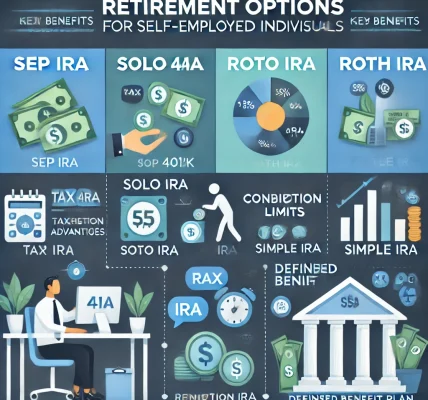Introduction
One of the biggest concerns retirees face is managing their retirement withdrawals efficiently while minimizing taxes. Without proper planning, taxes can take a significant portion of your hard-earned savings, reducing the amount available for your retirement lifestyle. Fortunately, there are several strategies you can use to legally reduce taxes on your retirement withdrawals and keep more money in your pocket.
In this guide, we will explore various tax-efficient withdrawal strategies, the best retirement accounts to use, and how to plan for long-term tax savings.
Understanding How Retirement Withdrawals Are Taxed
Before diving into tax-saving strategies, it’s important to understand how different retirement withdrawals are taxed. Here are some common retirement income sources and their tax implications:
1. Traditional IRA and 401(k) Withdrawals
Withdrawals from Traditional IRAs and 401(k)s are taxed as ordinary income. The amount you withdraw will be added to your total income for the year, which can push you into a higher tax bracket.
2. Roth IRA and Roth 401(k) Withdrawals
Withdrawals from Roth accounts are tax-free as long as you meet the necessary requirements, including the five-year rule and being at least 59½ years old.
3. Social Security Benefits
A portion of your Social Security benefits may be taxable depending on your total income. If your combined income (adjusted gross income + nontaxable interest + half of your Social Security benefits) exceeds a certain threshold, up to 85% of your benefits may be taxable.
4. Pension and Annuity Payments
Most pensions are taxable as ordinary income. However, if you made after-tax contributions to your pension, a portion of your withdrawals may be tax-free.
5. Investment Accounts
Withdrawals from taxable brokerage accounts are subject to capital gains taxes, which may be lower than ordinary income tax rates if held for more than a year.
Strategies to Reduce Taxes on Retirement Withdrawals
1. Withdraw from Taxable Accounts First
A good tax-efficient withdrawal strategy is to use funds from taxable accounts before tapping into tax-deferred accounts. By doing this, you can allow your tax-advantaged accounts to continue growing while minimizing taxable income.
2. Implement a Roth Conversion Strategy
Converting portions of your Traditional IRA or 401(k) to a Roth IRA can help reduce future tax burdens. Since Roth withdrawals are tax-free, converting when you’re in a lower tax bracket can help minimize lifetime taxes.
3. Delay Social Security Benefits
If possible, delaying Social Security benefits until age 70 can increase your monthly payout and reduce the taxable portion of your benefits in earlier retirement years. This strategy works well if you have other sources of income to cover expenses.
4. Take Required Minimum Distributions (RMDs) Wisely
Once you turn 73 (or 75 starting in 2033), you must take Required Minimum Distributions (RMDs) from Traditional IRAs and 401(k)s. Failure to do so results in hefty penalties. If you don’t need the money immediately, consider reinvesting it in a taxable account with tax-efficient investments.
5. Use Qualified Charitable Distributions (QCDs)
If you’re 70½ or older, you can donate up to $100,000 per year directly from your IRA to a qualified charity. This reduces your taxable income and satisfies RMD requirements.
6. Consider Tax-Free Municipal Bonds
Municipal bonds provide tax-free interest income, making them an attractive investment option for retirees looking to reduce taxable income while still earning returns.
7. Use the Standard Deduction and Itemized Deductions
Ensure you take full advantage of the standard deduction or itemize deductions where beneficial. Retirees with high medical expenses, mortgage interest, or charitable contributions may benefit from itemizing deductions to reduce taxable income.
8. Move to a Tax-Friendly State
Some states have no income tax, and others offer exemptions for retirement income. Consider relocating to a state with lower taxes to maximize your retirement savings.
9. Strategically Withdraw Funds to Stay in a Lower Tax Bracket
By carefully managing withdrawals, you can stay within a lower tax bracket and avoid pushing yourself into a higher one. Work with a financial advisor to calculate the optimal withdrawal amount each year.
Tax-Efficient Withdrawal Sequence
A general tax-efficient withdrawal order looks like this:
- Withdraw from taxable brokerage accounts (to use low long-term capital gains rates).
- Withdraw from tax-deferred accounts (Traditional IRA, 401(k), etc.) up to your standard deduction.
- Withdraw from Roth accounts last to maximize tax-free growth.
Final Thoughts
Taxes can take a significant chunk out of your retirement income, but with careful planning, you can minimize their impact. Strategies such as tax-efficient withdrawals, Roth conversions, delaying Social Security, and charitable donations can help you keep more of your hard-earned money.
Work with a tax professional or financial advisor to create a personalized withdrawal strategy that aligns with your retirement goals and minimizes tax liabilities. With the right approach, you can enjoy a comfortable and financially secure retirement while keeping more money in your pocket.




